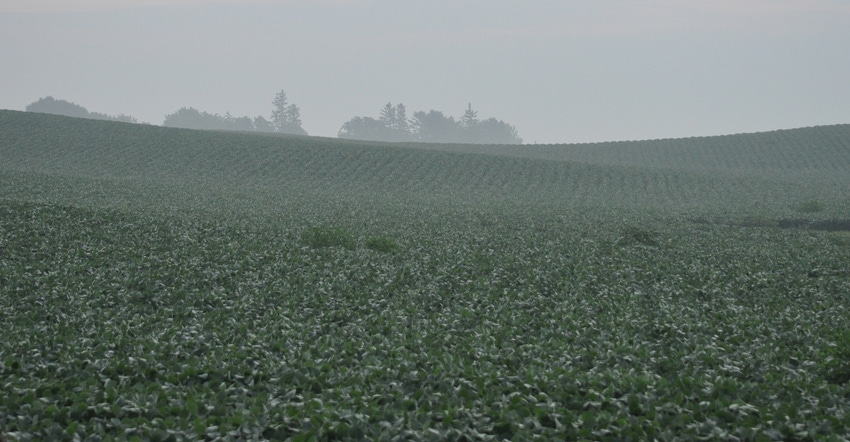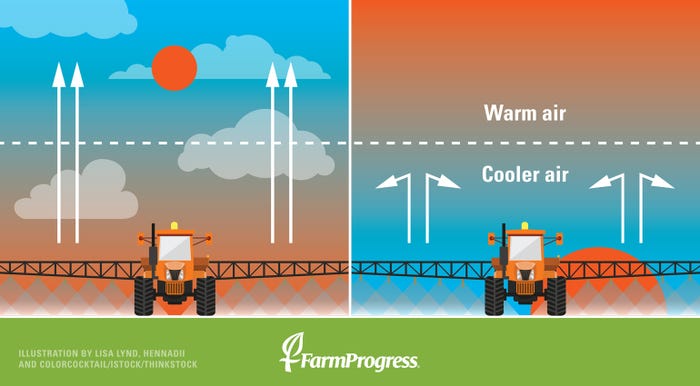
How do spray droplets travel 3 or more miles off-target when there’s no wind? Two words: temperature inversion. That’s why Andrew Thostenson, North Dakota State University Extension specialist, says herbicide applicators need to recognize the signs and stop spraying when temperature inversions are present or setting up.
Thostenson explains that applications during an inversion will take longer to hit the target, and the dense air will move droplets laterally. “Inversions don’t create spray drift, but they certainly exacerbate it,” he says.
The updated 2018 Engenia, XtendiMax and FeXapan labels prohibit dicamba applications at night, which is prime time for temperature inversions. Some states, like North Dakota, limit applications to from one hour after sunrise to one hour before sunset. Wind speeds must be at least 3 mph and below 10 mph.
That’s a good baseline, Thostenson says, but inversions can start late in the afternoon and occur in wind speeds up to 6 mph. “These are the hours that keep me awake at night, and they should keep you awake at night,” he says. “The afternoon-evening inversions are the worst.”
Here are four ways to identify a temperature inversion, according to Thostenson.
1. Use your eyes. Does dust disperse quickly behind a truck or tractor, or does it linger? Looming dust particles are a good indicator of an inversion. Look up. Is there at least 25% cloud cover? Inversions occur on sunny afternoons with cloudless skies. In the morning hours, dew, frost and fog indicate overnight temperature inversions.
2. Use your nose. Can you smell a hog farm that’s 3 miles away? What about the neighbor’s barbecue or bonfire? Odors stay close to the ground during inversions.
3. Use your ears. Can you hear a train that’s 6 miles away? “Sound waves carry intensely during an inversion,” Thostenson explains. “Sound waves are bent by the dense air that’s close to the ground.”
4. Check the weather. Be prepared for inversions if your local weather forecaster talks about a high-pressure system. “That’s when inversions will be the worst,” Thostenson says.
Cold soils and low moisture also come into play. “Think about moisture as a buffering device,” Thostenson says.
The following soil situations “can make matters worse” for temperature inversions:
• sandy soils or soils that do not retain moisture or heat
• freshly tilled soil
• fields with heavy crop residue, like no-till
• fields surrounded by windbreaks casting shadows on the crop
• a closed canopy
• low-lying fields
 ANATOMY OF AN INVERSION: On a clear day with little to no wind, cool air sinks as the sun sets. Without warmth from the sun or wind to circulate the air, cool, dense air forms near the surface.
ANATOMY OF AN INVERSION: On a clear day with little to no wind, cool air sinks as the sun sets. Without warmth from the sun or wind to circulate the air, cool, dense air forms near the surface.

Tough call
Thostenson offers one last piece of advice before application season. “Do not rely on an app to make your application decision. I can’t emphasize this enough,” he says. “Why would you make an assessment off a phone that’s using interpretative data from multiple tower locations, and it may not be at all what it’s like in that field?”
Apps and other tools, such as hourly NOAA forecasts, provide information for planning future applications. Thostenson recommends using the predicted average wind speeds to narrow down potential application windows.
When applicators pull into a field, it’s time to address all the label application requirements and be prepared to halt operations. Thostenson says new tools like the SpotOn Inversion Tester from Innoquest can be used prior to applications. The tester measures air temperature at boom height and identifies inversions.
“You have to know what’s happening in your field; there’s no substitute for that,” he says.
About the Author(s)
You May Also Like




